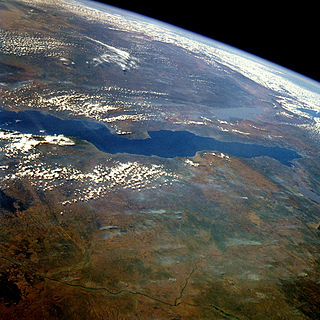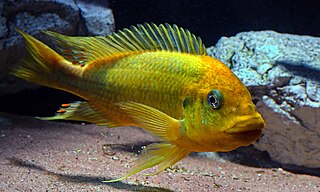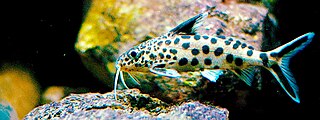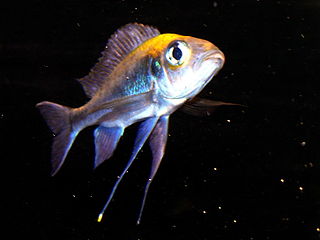
Lake Tanganyika is an African Great Lake. It is the second-oldest freshwater lake in the world, the second-largest by volume, and the second-deepest, in all cases after Lake Baikal in Siberia. It is the world's longest freshwater lake. The lake is shared among four countries—Tanzania, the Democratic Republic of the Congo (DRC), Burundi, and Zambia, with Tanzania (46%) and DRC (40%) possessing the majority of the lake. It drains into the Congo River system and ultimately into the Atlantic Ocean.

Julidochromis is a genus of cichlids in the subfamily Pseudocrenilabrinae. They are commonly called julies and are endemic to Lake Tanganyika in eastern Africa. This genus includes six formally described species, some with a number local variants of uncertain taxonomic status. Further taxonomic work is required to determine how many species exist; the closely related Chalinochromis with two more species is sometimes included here and this may be correct. Hybridization makes attempts to determine relationships with molecular phylogenetic methods difficult.

Tropheus moorii is a species of cichlid endemic to Lake Tanganyika in Africa. Over 40 different color morphs of this species are dispersed throughout the lake, ranging from dark green to flame red and yellow. They mostly feed on filamentous algae on the rocky shallows they inhabit. T. moorii is a maternal mouthbrooder, so eggs are fertilized and young are carried in the mouth of the female while they hatch and develop.

Petrochromis is a genus of cichlids endemic to Lake Tanganyika in east Africa.

Synodontis multipunctatus, also known as the cuckoo catfish, cuckoo squeaker, or multipunk, is a small catfish from Lake Tanganyika, one of the lakes in the Great Rift Valley system in Africa. It is a brood parasite upon mouthbrooding cichlids. This species grows to a length of 27.5 centimetres (10.8 in) TL. This species is a minor component of local commercial fisheries.

Altolamprologus compressiceps is a species of fish in the family Cichlidae. It is endemic to the shallow rocky areas of Lake Tanganyika. It is not considered threatened by the IUCN.

The featherfin cichlid is a species of cichlid endemic to Lake Tanganyika where it is found off rocky slopes. It feeds on plankton. This fish can reach a length of 21 centimetres (8.3 in) TL. It can also be found in the aquarium trade. This is currently the only species recognized in the genus by FishBase, but genetics and morphology suggest there are two valid species. The second is frequently called C. foae in the aquarium trade, but a review of the type specimen is needed to clarify if this is the correct name.

Lamprologus callipterus is a species of cichlid endemic to Lake Tanganyika where it very actively moves about in search of crustaceans and other invertebrates. Males of this species can reach a length of 12.4 centimetres (4.9 in) TL while the females only grow to 4.5 centimetres (1.8 in) TL. This fish can also be found in the aquarium trade, though it is considered to be poorly suited for captivity.

Lepidiolamprologus cunningtoni is a species of cichlid endemic to Lake Tanganyika where it prefers areas with sandy substrates in which it digs crater-shaped nests. This carnivorous species takes fish as prey. This species can reach a length of 29.1 centimetres (11.5 in) TL. This species inclusion in this genus has been questioned based upon its lacking many of the characteristics of its congeners. It can also be found in the aquarium trade. The specific name of this fish honours the British zoologist William Alfred Cunnington (1877-1958), who collected the type on an expedition to Lake Tanganyika.

Limnotilapia dardennii, the latticed cichlid, is a species of cichlid endemic to Lake Tanganyika, where it prefers rocky areas near the coast. It may also be found in the aquarium trade. This species is currently the only known member of its genus.
Neolamprologus buescheri is a species of cichlid endemic to Lake Tanganyika. This species can reach a length of 8 centimetres (3.1 in) TL. It can also be found in the aquarium trade. The specific name of this cichlid honours the collector of its type, the German ichthyologist Heinz H. Büscher.
Neolamprologus falcicula is a species of cichlid endemic to Lake Tanganyika where it is only known from the waters off Burundi. The yype locality is the Magara coast of Burundi, at a depth of ten meters. This species can reach a length of 8.1 centimetres (3.2 in) TL. It can also be found in the aquarium trade.

Neolamprologus fasciatus is a species of cichlid endemic to Lake Tanganyika. This species spawns in empty snail shells. This species can reach a length of 15 centimetres (5.9 in) TL. This species can also be found in the aquarium trade. They are piscivores and their prey includes the cichlid fish Variabilichromis moorii.
Neolamprologus savoryi is a species of cichlid endemic to Lake Tanganyika. This species reaches a length of 8 centimetres (3.1 in) TL. It can also be found in the aquarium trade. The specific name of this cichlid honours Bryan Wyman Savory (1904-1988) who was the District Commissioner of Kigoma in the Tanganyika Territory during the Belgian Hydrobiological Mission to Lake Tanganyika of 1946–1947, this expedition collected the type.
Neolamprologus splendens is a species of cichlid endemic to Lake Tanganyika where it is only known to occur around Cape Zongwe in the Democratic Republic of the Congo. The type locality is Near Cape Zongwe, Lake Tanganyika. This species can reach a length of 8 centimetres (3.1 in) TL.

Perissodus microlepis is a species of cichlid endemic to Lake Tanganyika. This species reaches a length of 11 centimetres (4.3 in) TL. This species can also be found in the aquarium trade. It is a scale-eating 'parasite' on other fish species. It occurs in two distinct morphological forms. One morph has mouth parts twisted to the left, enabling it to eat scales off its victim's right flank. In contrast, the other morph, whose mouth is twisted to the right, eats scales off its victim's left flank. The relative abundance of the two morphs in populations is regulated by frequency-dependent selection.
Petrochromis famula is a species of cichlid endemic to Lake Tanganyika on rocky substrates on which they can graze. This species can reach a length of 15.1 cm (5.9 in). It can be found in the aquarium trade.
The threadfin cichlid is a species of cichlid endemic to Lake Tanganyika found in areas with rocky substrates on which it can graze on algae. This species can reach a length of 18 cm (7.1 in). It can be found in the aquarium trade. The specific name of this cichlid honours the British ichthyologist Ethelwynn Trewavas (1900-1993).

The spotfin goby cichlid is an African species of cichlid endemic to Lake Tanganyika where it is only known from the northern end of the lake. They live amongst pebbles in the surf-zone. This species can reach a length of 7 centimetres (2.8 in) TL. This species can also be found in the aquarium trade. Although presently considered the only species in the genus, another undescribed species is known from the Lukuga River.

The yellow sand cichlid is a species of cichlid endemic to Lake Tanganyika where it is found in schools in areas with sandy substrates. This species can reach a length of 9.2 centimetres (3.6 in) TL. It can also be found in the aquarium trade.















